
Publisher:
Bonnie King
CONTACT:
Newsroom@Salem-news.com
Advertising:
Adsales@Salem-news.com

~Truth~
~Justice~
~Peace~
TJP
Mar-21-2012 19:07


 TweetFollow @OregonNews
TweetFollow @OregonNews
Further Evidence of War Crimes in Sri Lanka
The Death of Colonel Ramesh
Salem-News.com
Graphic images of suspected war crimes and murder; read with caution.
 T. Thurairajasingham, whose call sign was Romeo Sierra, and nom de guerre was Colonel Ramesh |
(COLOMBO Lanka News Web) - New evidence of the murder of one man is key to revealing a conspiracy behind mass murder. This evidence, shown and told in The Global Mail’s story, is graphic and confronting. The issue is now being debated by the United Nations.
This single murder, insignificant of itself, suggests the systematic, large-scale killing of prisoners — civilians and fighters — by the Sri Lankan authorities.
Because the interrogators are Sri Lankan soldiers, and the prisoner is Tamil, and neither understands the native language of the other, the interrogation is conducted in patchy English. Earlier, Ramesh had been told, “Don’t be afraid,” by the interrogating officer. “We want information only. Okay, now you are safe. Here is the army personnel, we are not going to harass you, you just tell the truth.” Sri Lanka has seemed so unconcerned by international criticism that it has appointed military men with command responsibility over alleged war crimes to diplomatic posts, even sending them to represent Sri Lanka at the UN.
There's an intriguing video that's been available online for a little less than a year. When properly considered, along with fresh pieces of a jigsaw puzzle, it might ensure the passage this week of a resolution being considered by the UN Human Rights Council in Geneva. The resolution is being furiously opposed by The Sri Lankan government.
The video shows a man in the custody of the Sri Lankan armed forces, excerpts from his interrogation and preparations to conceal his impending execution. It's important because, together with a batch of newly discovered photographs, it is evidence of a chain of events that places this man consistently in the custody of authorities until his murder and the disposal of his body.
This single murder, insignificant of itself, suggest the systematic, large-scale killing of prisoners - civilians and fighters - by the Sri Lankan authorities. These are the murders that the government has long denied, and which, when asked, they say didn't happen, or if they did were committed by the Tamil Tigers (LTTE) themselves. When pressed, they ask for the evidence, assert that the recorded images are fakes, or request the names of witnesses, such as several Sinhalese troops who already have come forward to provide secret testimony of war crimes.
Like all the other electronically recorded images that have emerged since the end of the war, there is nothing particularly furtive about these sequences. They were recorded by young men with mobile telephones, as trophy videos or as intelligence records. There are many fellow soldiers around, and they are relaxed and often smiling and joking as they go about their work. This is not a secret after all: they are responding to orders, issued by their commanders.
The context In the final months of the war, Sri Lanka's army had surrounded the Tamil Tiger guerrillas and some 330,000 Tamil civilians on a small sandy strip on the island's coastline. Although beaten, the Tigers refused to surrender, and they used the civilians with them as a shield against an all-out assault by the army.
Nevertheless, the Sri Lankan army did attack, with bombardment, commando raids and assault teams, which combined to breach the thin Tiger defences. The army managed to release tens of thousands of terrified civilians, who streamed across a low lagoon while the battle raged behind them. Many civilians died, and many Tiger fighters discarded their weapons, and escaped with them. The final shots were fired on or around May 18, 2009.
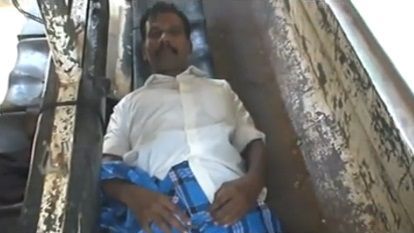 |
One who escaped was T. Thurairajasingham, whose call sign was Romeo Sierra, and nom de guerre was Colonel Ramesh. He was a senior commander in the Tamil Tigers. He is the man in the video linked to above. A witness statement places Ramesh at the lagoon on May 17, dressed in a white shirt and sarong, crossing with his family, with one of his children in his arms.
Sensibly, knowing the battle lost, he had discarded his weapon and hoped to blend into the civilian columns, in order to preserve the lives of his family as well as his own. Once on the other side, he was recognized by the military and arrested. He was taken like almost 300,000 others to one of the detention camps in the town of Vavuniya.
Another witness saw him in the camp wearing a white shirt and blue-checked sarong, separated off with other Tamil Tigers who had been similarly recognised. As we can now surmise, he was eventually taken from the camp on May 22.
The interrogation
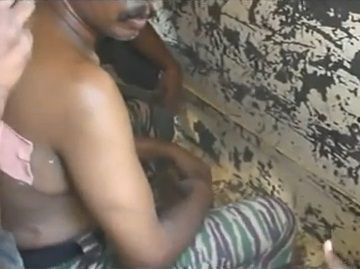 |
The first frames in the video sequence show Ramesh lying on his back on the floor of a crude armoured personnel carrier (APC). He is clean and dry and wearing a fresh sarong and shirt. He shows no sign of the filth and sweat of the battlefield or the months-long siege. Indeed, he is wearing precisely the same civilian clothes worn by many men in the detention camps at the end of the war. His clothes alone narrow him to a time and place. His captor is standing at his feet, filming him.
Next, a shirtless Ramesh has been given a pair of clean camouflaged Tamil Tiger trousers to wear (see gallery). He is now sitting in the APC. At various stages, some six to eight uniformed soldiers can been seen or heard questioning him and examining him. The soldiers' white, cotton-thread wristbands denote that they are Buddhists, the religion of the island's predominant Sinhalese population.
Because the interrogators are Sri Lankan soldiers and the prisoner is Tamil, and neither understands the native language of the other, the interrogation is conducted in patchy English. Occasionally, as the interview unfolds, the surrounding few troops exchange remarks between each other in Sinhala, the language of the army and police of Sri Lanka.
Ramesh has a freshly applied and clean dressing on his back. An off-camera soldier lifts the dressing to reveal a very old wound, which Ramesh says dates from 1988, and a fresh, suppurating wound that has been plugged with gauze.
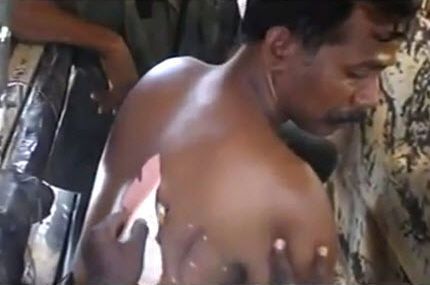 |
The dressing also places Ramesh in time and context. The dressing is as clean as he is. His battle wound has been dressed in the detention camp. We know this because after months of siege, there were no more dressings to be had and in the Nandikadal lagoon, if they were available to a senior commander at all, they would have been quickly dirtied in the siege and battle zone.
At one stage, one of the soldiers says in Sinhala to his comrades, "When you hear what you want, let's do it, let's do it."
The videoed interrogation now moves between two locations. The APC, where the engine can be heard running, and the second location, which is a mud brick and thatch building. The condition of this second location - rubble from a broken wall, detritus of cloth, and a hole in another wall - suggests that he has been taken back to the site of a battle. By the time he has reached this second location, he has been changed again. Gone are his Tiger stripes, and instead he has been instructed to change into the ordinary fatigues of a soldier of the army of Sri Lanka.
By now Ramesh is more clearly frightened. Earlier, Ramesh had been told, "Don't be afraid," by the interrogating officer. "We want information only. Okay, now you are safe. Here is the army personnel, we are not going to harass you, you just tell the truth." But Ramesh knows that as a senior Tamil Tiger commander, he is unlikely to receive mercy from his captors. He licks his dry lips, and at one point raises his hands in fear when the leading interrogator becomes angry, stands over him and threatens him in some way we cannot see because he is off camera.
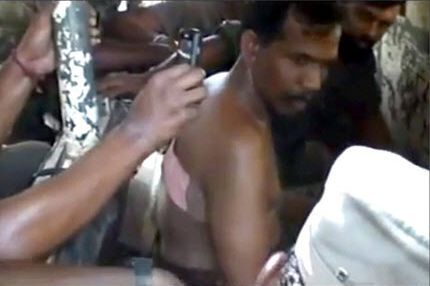 |
From the interrogation at these two locations, we learn a number of things. His name, his birth date, his rank and the date he joined the Tigers. He is persistently asked for the whereabouts of a Tiger commander from Batticaloa, a town on the east of the island, who evidently has evaded capture. He names his own wife and three children, a boy aged seven, and two girls aged nine and two. He confirms that they are now in one of the detention camps in Vavuniya. An off-camera soldier pats him soothingly on the back.
More prosaically, we know also that, for so long as we live, we live in hope. This tough, ruthless, highly disciplined, professional fighter - like the birds we can hear in the trees, also recorded - begins to sing in the small hope that by cooperating he might save his life. He provides the names of his comrades, the men who were probably at that stage still in Batticaloa running the remnants of the underground Tiger movement, despite the town's earlier capture by the army; Kumaran, who is apparently still in charge of military affairs, and Tayamohan, who is the political cadre.
We learn also that the prisoner was at Nandikadal lagoon; "At Nandikadal, did you see the leader's wife?" he is asked. There is only one leader superior to Colonel Ramesh, and it is The Leader, a.k.a. Velupillai Prabhakaran, the founder and commander of the Tamil Tigers.
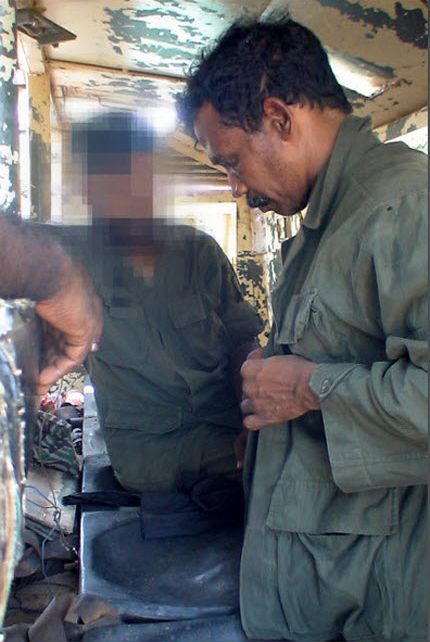 |
Another marker of time and place is revealed when he is asked, "Where is your leader's daughter?" So we know that the army is trying to account for the family of Prabhakaran, which we also know from a variety of evidence, could only have happened on or after May 18, when the final patch of land held by the Tigers was captured.
On or around that date, the last of the family were being rounded up. Parts of another video used in the latest Channel 4 video, illustrates the fate of The Leader's son, 12 year-old Balichandran, captured and executed at close range, probably on May 18. The difference between the evidence of the boy's killing and the interrogation and death of Ramesh is that while the former shows the aftermath of an appalling murder, the latter shows a murder, from custody to death and disposal of the corpse by the Sri Lankan military.
Before his death, the prisoner and the interrogator share a moment, when it is confirmed that they were both present at the 2006 battle of Thoppigala in eastern Sri Lanka. "I know that you participated in the Thoppigala battle, because I was also there…" says his captor. However it is not enough for the two men to bond, because shortly the interrogator becomes angry. "Don't tell a lie!" he shouts, while Ramesh cowers, raises his hands, and says "I understand, I understand," in an effort to placate. But the two men don't understand each other very well, which is what makes this interview so awkward and crude but ultimately so revealing.
For example, in the course of the exchange, as each misunderstands the other, we learn that the date is May 22. "When you going back refugees camp [sic]?" ask the interrogator in his broken English, when he actually means to ask "When did you reach the refugee camp?" knowing that Ramesh had entered the detention camp in Vavuniya at 4.30am on May 17, five days earlier. Thus, we have another series of time and location markers, which coincide with the metadata of the video that shows it was transferred from recording device to computer on May 22, later the same day of the interrogation.
Death, and disposal
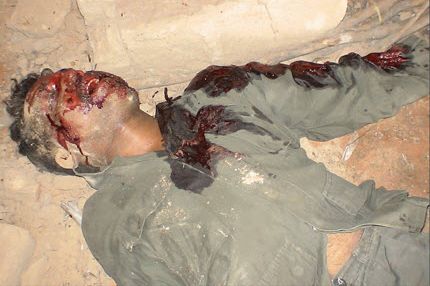 |
May 22, 2009 also coincides with the existing metadata on a series of newly revealed photos. These photos were apparently taken by other soldiers using mobile telephones, or were lifted as stills from the video footage under consideration. The images record the passage of time from the interrogation of Ramesh, to his various changes of clothes and locations. They do not show the actual point of death, but they do show his corpse moments after he has been shot through the side of the head by a large calibre bullet. It shows Sri Lankan troops (their faces and military insignia clear) as they pose for trophy shots next to the burning corpse.
The Global Mail has examined these images with lawyers and senior police investigators. In the words of one investigator, a former police officer, these images leave "no doubt" and are prima facie evidence that a crime has been committed, showing victim, place, time and overwhelming evidence of perpetrators at the crime scene and engaged in the concealment of the death. Of course, in case you'd missed it, it made better sense for the body to be dressed in a Sri Lankan army uniform, leaving no messy traces of Tiger stripes.
Photos of the corpse of The Leader's daughter, Duvarika, have since emerged. Evidently, she met a violent end, too. Prabhakaran's eldest son, Charles Anthony, aged 22, apparently died in the final days of the war. There are literally hundreds of photos and videos of corpses that have been bound, mutilated, systematically executed and sexually violated by persons unknown - but then disposed of by soldiers of the army of Sri Lanka.
A United Nations panel of experts determined in April last year that enough credible allegations of war crimes and crimes against humanity — the systematic bombarding of areas of civilian concentration, starvation tactics, hostage-taking, the illegal executions of prisoners, the targeting of schools and hospitals — exists to warrant a proper investigation. A subsequent investigation instigated under international pressure by the Sri Lankan government found that while there may have been aberrations committed by Sri Lanka's military, determining criminal responsibility was impossible for lack of evidence.
The international context
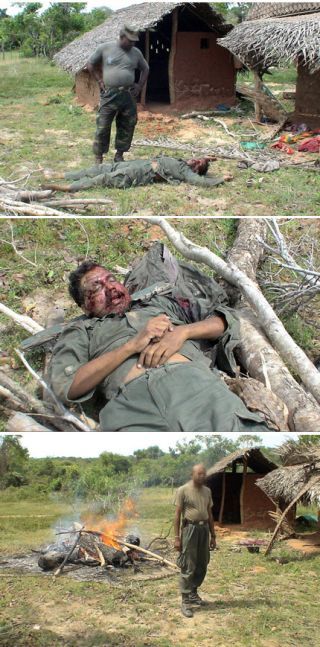 |
Peace between two peoples is of primary importance in Sri Lanka, as in any conflict, once the dust has settled. But the persistent, dogged denial of any wrong-doing by the government of Sri Lanka has frustrated the UN as well as the United States and European Union. Today the Australian Senate passed a resolution in support of a US proposed resolution that would tie the government of Sri Lanka to a specific accountability process. It is due to be voted on at the UN Human Rights Council in Geneva this week.
Throughout the war and since, Sri Lanka's leaders have insisted that their war was "bloodless" in terms of civilians killed. Sri Lanka has seemed so unconcerned by international criticism that it has appointed military men with command responsibility over alleged war crimes to diplomatic posts, even sending them to represent Sri Lanka at the UN. As a result it is likely that even her ally India will vote against Sri Lanka in the current resolution.
Prasad Kariyawasam, Sri Lanka's envoy to India, said, "We're very surprised on the US trying to force our hand on what we're doing naturally. This kind of pressure, the public will see as not helpful. It will delay our reconciliation process." Of the video of the murder of 12-year-old Balachandran, Mr. Kariyawasam dismissed it as "not corroborated". Last month, Sri Lanka's minister for human rights, Mahinda Samarasinghe, told the UN Human Rights Council that the government was engaged in reconciliation and that outside pressure would spoil its efforts.
Writing to Archbishop Desmond Tutu, who has called for the UN resolution to be passed, Sri Lanka's External Affairs Minister, G.L. Peiris, said that UN action "would only lead to derailing the ongoing reconciliation process that has been put in place by the government". Yet there are almost no detectable signs of any such process. Sri Lanka's judiciary and police force remain crippled by a residual culture from 30 years of war. In November 2011 the UN Committee Against Torture published a damning report on Sri Lanka, revealing the extent of allegations of human rights violations perpetrated by the state.
Sri Lanka has been an astute manipulator of international processes. In June 2009, a first resolution put by western nations to the UN Human Rights Council, which criticized Sri Lanka's conduct of the war, was deftly transformed by Sri Lankan diplomats into a resolution of praise. Of the mass of available evidence, the most compelling trail is that of Colonel Ramesh. His death provides a crack of light that illuminates the deaths of thousands of others, and the motives of the probable perpetrators.
 |
The Death Of Colonel Ramesh - Global Mail
 |
 |
 |
 |
 |
 |
Articles for March 20, 2012 | Articles for March 21, 2012 | Articles for March 22, 2012

Quick Links
DINING
Willamette UniversityGoudy Commons Cafe
Dine on the Queen
Willamette Queen Sternwheeler
MUST SEE SALEM
Oregon Capitol ToursCapitol History Gateway
Willamette River Ride
Willamette Queen Sternwheeler
Historic Home Tours:
Deepwood Museum
The Bush House
Gaiety Hollow Garden
AUCTIONS - APPRAISALS
Auction Masters & AppraisalsCONSTRUCTION SERVICES
Roofing and ContractingSheridan, Ore.
ONLINE SHOPPING
Special Occasion DressesAdvertise with Salem-News
Contact:AdSales@Salem-News.com


Salem-News.com:

Terms of Service | Privacy Policy
All comments and messages are approved by people and self promotional links or unacceptable comments are denied.
[Return to Top]
©2025 Salem-News.com. All opinions expressed in this article are those of the author and do not necessarily reflect those of Salem-News.com.